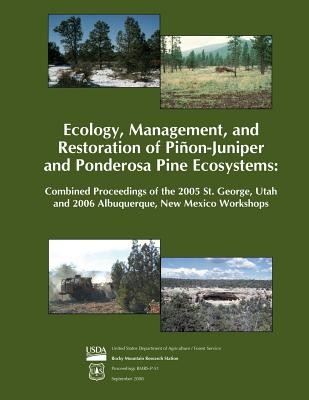
- We will send in 10–14 business days.
- Author: United States Department of Agriculture
- Publisher: CreateSpace Independent Publishing Platform
- ISBN-10: 1511537965
- ISBN-13: 9781511537964
- Format: 21.6 x 28 x 1.2 cm, softcover
- Language: English
- SAVE -10% with code: EXTRA
Ecology, Management, and Restoration of Pinon- Juniper and Ponderosa Pine Ecosystems (e-book) (used book) | bookbook.eu
Reviews
Description
Southwestern piñon-juniper and juniper woodlands cover large areas of Arizona, New Mexico, Utah, and adjacent Colorado. Ponderosa pine forests are the most common timberland in the Southwest. All three ecosystems provide a variety of natural resources and economic benefits to the region. There are different perceptions of desired conditions. Public and private land managers have adapted research results and their observations and experiences to manage these ecosystems for multiresource benefits. Ways to mitigate the threat of wildfires is a major management issue for these ecosystems, and the wide-spread piñon mortality related to drought and the bark beetle infestation has heightened concerns among managers and the general public. In addition, the impacts of climate change on these ecosystems are a growing concern. As a step in bringing research and management together to answer some of these questions, workshops concerned with the ecology, management, and restoration of piñon-juniper and ponderosa pine ecosystems were held in St. George, Utah in 2005 and in Albuquerque, New Mexico in 2006. The combined proceedings from these two workshops contain papers, extended abstracts, and abstracts based on oral and poster presentations. Some topics included forest and woodland restoration treatments and their impacts on fuels, wildlife, and other ecosystem components, watershed management, insect infestations and drought, wood utilization, landscape changes, basic ecology, and more.
EXTRA 10 % discount with code: EXTRA
The promotion ends in 18d.16:16:23
The discount code is valid when purchasing from 10 €. Discounts do not stack.
- Author: United States Department of Agriculture
- Publisher: CreateSpace Independent Publishing Platform
- ISBN-10: 1511537965
- ISBN-13: 9781511537964
- Format: 21.6 x 28 x 1.2 cm, softcover
- Language: English English
Southwestern piñon-juniper and juniper woodlands cover large areas of Arizona, New Mexico, Utah, and adjacent Colorado. Ponderosa pine forests are the most common timberland in the Southwest. All three ecosystems provide a variety of natural resources and economic benefits to the region. There are different perceptions of desired conditions. Public and private land managers have adapted research results and their observations and experiences to manage these ecosystems for multiresource benefits. Ways to mitigate the threat of wildfires is a major management issue for these ecosystems, and the wide-spread piñon mortality related to drought and the bark beetle infestation has heightened concerns among managers and the general public. In addition, the impacts of climate change on these ecosystems are a growing concern. As a step in bringing research and management together to answer some of these questions, workshops concerned with the ecology, management, and restoration of piñon-juniper and ponderosa pine ecosystems were held in St. George, Utah in 2005 and in Albuquerque, New Mexico in 2006. The combined proceedings from these two workshops contain papers, extended abstracts, and abstracts based on oral and poster presentations. Some topics included forest and woodland restoration treatments and their impacts on fuels, wildlife, and other ecosystem components, watershed management, insect infestations and drought, wood utilization, landscape changes, basic ecology, and more.


Reviews